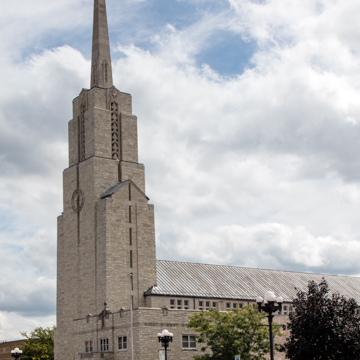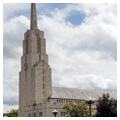St. Joseph’s enormous tower, which dominates the landscape of downtown La Crosse, steps back in several cubic stages before culminating in a slender faceted spire. It creates a modern expression of religious aspiration, combining the soaring verticality of the Gothic Revival with the spare simplicity of modernist design. Schulte of Cincinnati used a series of setbacks along the sides of the church, which complement the form of the tower. The strong vertical lines of the belfry’s trefoils are echoed in the narrow lancet windows, filled with stained glass and tracery, which rhythmically score the sides of the nave. Most striking of all is the church’s austere simplicity, which presaged the reforms of the Second Vatican Ecumenical Council of 1962–1965. The embellishment that exists stands out against the stark, random-coursed Lannon stone walls. The most decorative element is the pointed-arched entrance set at the tower’s base. A relief of St. Joseph, clutching a saw and chisel, occupies the niche above the door. Lilies at the saint’s feet symbolize purity, while a carpenter’s square signifies his trade.
The interior is glorious. Twenty-two Gothic arches, built of the same Bedford (Indiana) limestone that trims the church exterior, vault the airy nave. Instead of springing from the tops of the walls, as they traditionally would, the pointed arches curve gently from the floor to the vaults. Between the ribs in the ceiling, panels gilded with designs inspired by the Hiberno-Saxon Book of Kells shed a warm glow over the mahogany pews below. Behind the altar, a compound arch of stone and gilded plaster frames a stained glass window by Anton Wendling of Germany that fills almost the entire wall. Wendling also designed the clerestory windows. The stained glass windows in the nave and chapel are by Englishman Leo Cartwright. Windows on the nave’s east side depict a theological theme, and those on the west narrate the church’s history from the apostles to the establishment of the La Crosse diocese. German craftsman Gerhard Stoettner fabricated all the windows. The church was built by Orville Madsen and mason Helge Carlson.


















